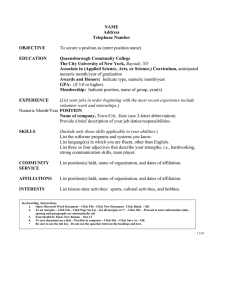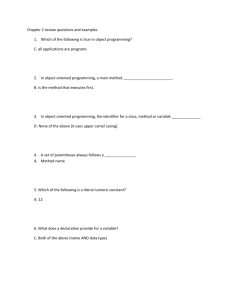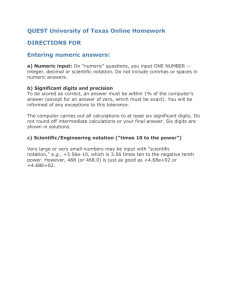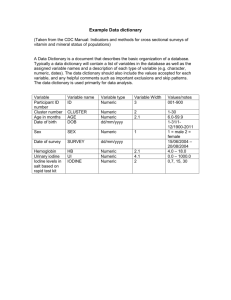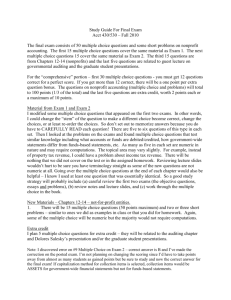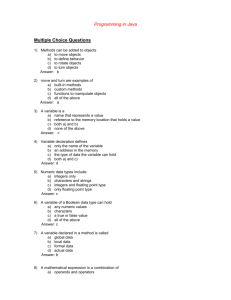Over-Subscription Planning with Numeric Goals
advertisement
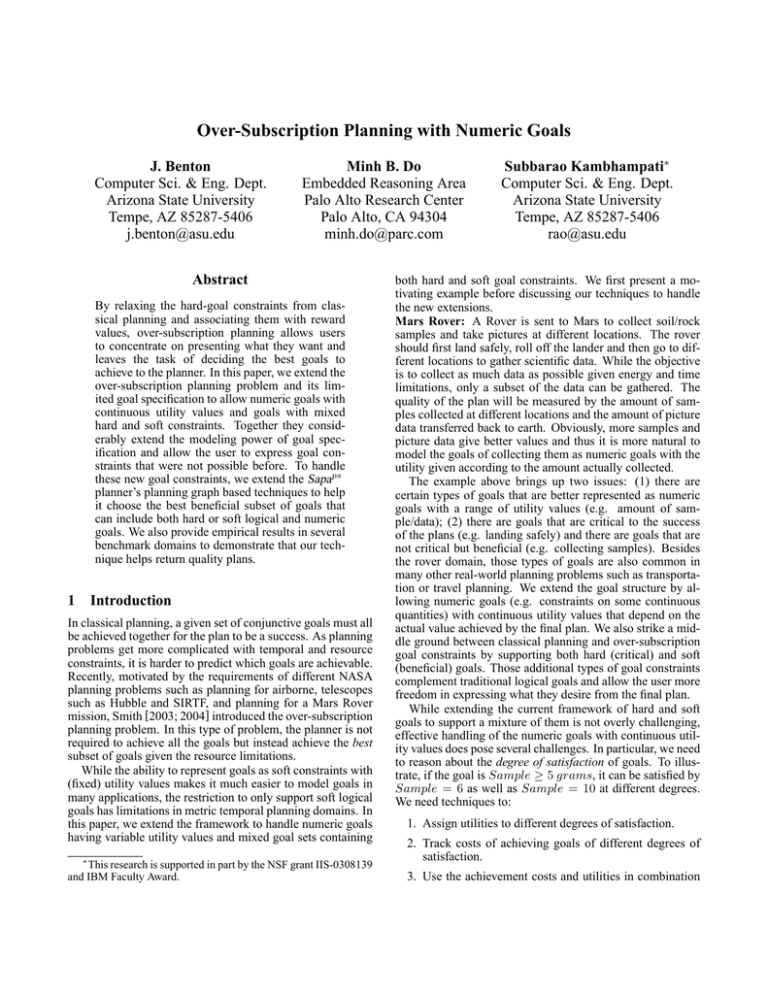
Over-Subscription Planning with Numeric Goals
J. Benton
Computer Sci. & Eng. Dept.
Arizona State University
Tempe, AZ 85287-5406
j.benton@asu.edu
Minh B. Do
Embedded Reasoning Area
Palo Alto Research Center
Palo Alto, CA 94304
minh.do@parc.com
Abstract
By relaxing the hard-goal constraints from classical planning and associating them with reward
values, over-subscription planning allows users
to concentrate on presenting what they want and
leaves the task of deciding the best goals to
achieve to the planner. In this paper, we extend the
over-subscription planning problem and its limited goal specification to allow numeric goals with
continuous utility values and goals with mixed
hard and soft constraints. Together they considerably extend the modeling power of goal specification and allow the user to express goal constraints that were not possible before. To handle
these new goal constraints, we extend the Sapaps
planner’s planning graph based techniques to help
it choose the best beneficial subset of goals that
can include both hard or soft logical and numeric
goals. We also provide empirical results in several
benchmark domains to demonstrate that our technique helps return quality plans.
1
Introduction
In classical planning, a given set of conjunctive goals must all
be achieved together for the plan to be a success. As planning
problems get more complicated with temporal and resource
constraints, it is harder to predict which goals are achievable.
Recently, motivated by the requirements of different NASA
planning problems such as planning for airborne, telescopes
such as Hubble and SIRTF, and planning for a Mars Rover
mission, Smith [2003; 2004] introduced the over-subscription
planning problem. In this type of problem, the planner is not
required to achieve all the goals but instead achieve the best
subset of goals given the resource limitations.
While the ability to represent goals as soft constraints with
(fixed) utility values makes it much easier to model goals in
many applications, the restriction to only support soft logical
goals has limitations in metric temporal planning domains. In
this paper, we extend the framework to handle numeric goals
having variable utility values and mixed goal sets containing
∗
This research is supported in part by the NSF grant IIS-0308139
and IBM Faculty Award.
Subbarao Kambhampati∗
Computer Sci. & Eng. Dept.
Arizona State University
Tempe, AZ 85287-5406
rao@asu.edu
both hard and soft goal constraints. We first present a motivating example before discussing our techniques to handle
the new extensions.
Mars Rover: A Rover is sent to Mars to collect soil/rock
samples and take pictures at different locations. The rover
should first land safely, roll off the lander and then go to different locations to gather scientific data. While the objective
is to collect as much data as possible given energy and time
limitations, only a subset of the data can be gathered. The
quality of the plan will be measured by the amount of samples collected at different locations and the amount of picture
data transferred back to earth. Obviously, more samples and
picture data give better values and thus it is more natural to
model the goals of collecting them as numeric goals with the
utility given according to the amount actually collected.
The example above brings up two issues: (1) there are
certain types of goals that are better represented as numeric
goals with a range of utility values (e.g. amount of sample/data); (2) there are goals that are critical to the success
of the plans (e.g. landing safely) and there are goals that are
not critical but beneficial (e.g. collecting samples). Besides
the rover domain, those types of goals are also common in
many other real-world planning problems such as transportation or travel planning. We extend the goal structure by allowing numeric goals (e.g. constraints on some continuous
quantities) with continuous utility values that depend on the
actual value achieved by the final plan. We also strike a middle ground between classical planning and over-subscription
goal constraints by supporting both hard (critical) and soft
(beneficial) goals. Those additional types of goal constraints
complement traditional logical goals and allow the user more
freedom in expressing what they desire from the final plan.
While extending the current framework of hard and soft
goals to support a mixture of them is not overly challenging,
effective handling of the numeric goals with continuous utility values does pose several challenges. In particular, we need
to reason about the degree of satisfaction of goals. To illustrate, if the goal is Sample ≥ 5 grams, it can be satisfied by
Sample = 6 as well as Sample = 10 at different degrees.
We need techniques to:
1. Assign utilities to different degrees of satisfaction.
2. Track costs of achieving goals of different degrees of
satisfaction.
3. Use the achievement costs and utilities in combination
L1 Sample
to estimate the final plan that maximizes the overall net
benefit achievable from a given state.
We present SapaMps an extension of Sapaps [Do &
Kambhampati, 2004; van den Briel et al., 2004] to support
both numeric goals and mixed soft/hard goal sets. SapaMps
significantly extends the relaxed plan extraction procedure
used in Sapaps to support numeric goals.
We first briefly discuss the search framework used in
Sapaps in Section 2. We then show how to extend the cost
propagation and relaxed plan extraction routines to handle
metric quantities and the combination of soft and hard goals
in Section 3. We present empirical results on extended versions of some well-known planning benchmark domains in
Section 4 to show that the new techniques help find larger and
better quality plans. We conclude the paper with the related
work and discussion.
2 Background
We start with the formal definition of the over-subscription
(aka partial-satisfaction) planning problem. We then proceed by describing the Sapaps [Do & Kambhampati, 2004;
van den Briel et al., 2004] planner and its framework that
heuristically searches for good quality plans for the problem.
2.1
Over-Subscription Planning (OSP)
To formally define the over-subscription planning problems
[Smith, 2004; van den Briel et al., 2004], the following notations will be used: F is a finite set of fluents and A is a
finite set of actions, where each action consists of a list of
preconditions and a list of add and delete effects. I ⊆ F is
the set of fluents describing the initial state and G ⊆ F is the
set of goals. Hence we define a planning problem as a tuple
P = (F, A, I, G). The OSP problem is defined as follows:
Definition OSP N ET B ENEFIT: Given a planning problem
P = (F, A, I, G) and, for each action a ∈ A a “cost” ca ≥ 0
and, for each goal specification g ∈ G a “utility” ug ≥ 0: find
a finite sequence of actions ∆ = ha1 , ..., an i starting from
1
I
Pa state S maximizing the net benefit value
Pthat leads to
c
u
−
a∈∆ a , where SG is the set of goals satisfied
g∈SG g
in S.
Thus, in contrast to the classical planning problems, in
OSP no goal achievement is needed to qualify the plan as
valid (any sequence of actions is a valid plan). We thus put
emphasis on finding good quality plans where the objective
function is to maximize the tradeoff between total achieved
goal utility and total incurred action cost (both additive).
2.2 Sapaps : Heuristic search for OSP
Sapaps adapts the heuristic (progression) search framework
to solve OSP problems. The quality of each search node
S visited by the A* search algorithm in a forward planner is ranked
using the
P
P value f (S) = g(S) + h(S) with:
g(S) = g∈SG ug − a∈∆ ca . Starting from the initial state
I with the net benefit value g(I), Sapaps keeps track of all
the visited states S that have better g(S) values than the best
1
States are represented just as in the Sapa planner [Do & Kambhampati, 2003].
10
Rover
Sample
Picture
L2
3
5
L0
0
0
L0
10
M0,1
L0
10
L1
5
M0,2
3
C
5
L2
L1
3
Ced
5
L2
6
Ced
19
6
S1
4
S2
14
8
P2
Level 1
8
L1
5
3
Sa1
Pi2
L0
8
L2
M2,1
3
Sa2
Level 0
0
0
L0
Level 2
6
Sa1
3
Ced
17
S1
14
S2
8
P2
Level 3
Figure 1: Rover example and the planning graph
state visited before S. Thus, instead of finding a single plan,
the algorithm keeps searching for incrementally better plans
in terms of the achieved net benefit (g(S)) value. The heuristic value h(S) is calculated by extending the cost propagation
over the planning graph routine. It is followed by the relaxed
plan extraction process in Sapa [Do & Kambhampati, 2003].
The search stops when the first node in the queue has value
h(S) = 0 (i.e. f (S) = g(S)). For the rest of this section, we
will discuss the three steps in estimating the h(S) value.
Example: Figure 1 shows an example in the Mars Rover
domain along with the complete planning graph structure for
this example2 . The rover initially resides at location L0 and
needs to collect samples at L1 , and to take a picture of L2 .
The rover can: (1) move between two locations (MLx ,Ly );
(2) calibrate the equipment before taking sample/picture (C);
(3) collect a sample at location l (Sal ); and (4) take pictures
(P il ). Action execution costs are depicted next to each action
in the complete planning graph for the example shown in
Figure 1. The first action layer of the graph contains three
actions with their respective execution costs: CM0,1 = 10,
CM0,2 = 5, and CC = 3.
Cost-propagation over the planning graph: The planning
graph propagates the achievement cost of each predicate and
execution cost of each action forward starting at the initial
level/time-point until fix-point. To simplify the discussion
for this section, we will assume that all actions have unit duration.
Intuitively, the heuristic needs to realize that to be able to
take the picture at L2 we first need to have the camera calibrated and be at L2 . For each action a, its execution cost
Ca is static and different from the cost to enable its execution
cost(a), which is the cost to achieve all of its preconditions.
Thus, cost(P iL2 ) = cost(Ced)+cost(L2 ) = CC +CM0,2 =
5 + 3. We also want the heuristic to capture the fact that the
cost to have a picture involves the cost to enable execution
of P iL2 and the cost to actually carry out that action. Thus:
cost(PL2 ) = cost(P iL2 ) + CP iL2 = 8 + 4. The propagation
rules are:
1. Initially, at t = 0: (1) ∀p ∈ I : cost(p) = 0; (2)
∀p ∈
/ I : cost(p) = ∞; (3) ∀a ∈ A : cost(a) = ∞.
2. At
P level l:
(1) ∀a ∈ A : cost(al ) =
cost(p
l−1 ); (2) ∀p ∈ F : cost(pl ) =
p∈P recond(a)
2
We assume that the readers are familiar with the planning graph,
which was originally described in [Blum & Furst, 1997].
[S1;S2;P2]
L0
M0,2
[S1;S2]
C
Level 0
L0
[S1;S2;P2]
L2
[S1;S2]
Ced
[S1]
M2,1
[S2]
Sa2
10
S2
[P2]
Pi2
12
P2
Level 1
[S2;P2]
M0,2
[S2]
C
[S1]
L1
[S1]
Sa1
Level 2
8
S1
Level 3
10
[S2;P2]
L2
[S2]
Sa2
S2
[S2]
Ced
[P2]
Pi2
12
P2
Figure 2: The relaxed plan
minp∈Ef f ect(a) cost(al−1 )
Our heuristic is inadmissible due to the use of sum
propagation in calculating the cost to execute each action.
As we grow the graph, new actions and facts are introduced
and the cost to achieve facts (cost(p)) and execute actions
(cost(a)) decreases due to new ways to achieve and support
them. In Figure 1, we highlight the new facts and actions
introduced at each level and the new achievement costs for
each fact. For example, L1 first appears at level 1 with
cost(L1 ) = 10 (achievable by M0,1 ). The value of cost(L1 )
decreases to 8 at level 2 due to the new action M2,1 in level
1. While the set of achieved facts and supporting actions in
level 2 and level 3 are the same, we did not stop growing the
graph at level 2. This is because cost(S1 ) decreases at level
3 due to the reduction in cost(L1 ) at level 2 (which leads to
the decrease in cost(Sa1 )).
Extracting the relaxed plan: After terminating the costpropagation, the cost values can be used to extract the relaxed
plan RP , starting from all achieved goals G, as follows:
1. Starting from the last level, ∀g ∈ G at level l select
action a at the action level l − 1 that supports g with the
lowest cost.
2. When action a is selected at level l, then all preconditions p of a at the previous level will be added to G.
3. Stop when: G ⊂ I.
All the collected actions a and the causal links between
them make up the relaxed plan RP .
Refining the relaxed plan: For each goal g, we build the
goal supporting set GS for each proposition p and action a by
going backward using the extracted relaxed plan as follows:
• ∀g ∈ G : GS(g) = {g}
S
• GS(a) = GS(p) : p ∈ Ef f ect(a)
S
• GS(p) = GS(a) : p ∈ P recond(a)
Intuitively, for each action a, GS(a) is the set of goals
that a supports. Thus, the achievement of any goal in GS(a)
depends on the inclusion of a in the relaxed plan while for
any goal g ∈
/ GS(a), g will still be achievable without a.
In Figure 2, we show the goal supporting sets for all actions
and related propositions (e.g. GS(C) = {S1 , S2 }) and the
corresponding utility values (e.g. U til(S2 ) = 10) of the three
goals in the relaxed plan. For each set SG ⊂ G, let ASG =
a : GS(a) ⊂ SG be the set of actions supporting only goals
in SG . We will remove SG along with ASG from the relaxed
plan if Σa∈ASG cost(a) > Σg∈SG U til(g) (i.e. cost > utility).
In our ongoing example, only the goal set S = {S1 } can be
removed because cost(AS1 ) = cost(M2,1 ) + cost(Sa1 ) =
3 + 6 > U til(S1 ) = 8. Figure 2 shows the relaxed plan
before and after refinement.
The net benefit of the final relaxed plan is:
U til({S2 , P2 }) − cost({M0,2 , C, Sa2 , P i2 })
=
(10 + 12) − (5 + 3 + 6 + 4) = 4. This is used as
the heuristic value h(S) to guide the A* search algorithm. In general, we define RP (S) to be the relaxed
plan found for state S and U (Apply(RP (S), S)) to be
the utility achieved by applying all actions in the relaxed
plan to state S. The heuristic value is then calculated as:
h(S) = (U (Apply(RP (S), S)) − U (S)) − cost(RP (S))
where RP (S) is the final relaxed plan.
3
Handling Numeric Goals with Utility
Sapaps only supports logical achievement goals of the form
g = T rue (e.g. HasP icture(L2 )). However, if we have the
goal to collect at least m grams of a Mars soil sample at a
given location l (i.e. sample(l) > m), we can more naturally
represent it as a numeric goal.
3.1
Numeric Goal Representation
Unlike logical goals that only have true/false values, there
are an arbitrarily large number of values that can satisfy a
given numeric goal. We assign a range of continuous utility
values for numeric goals to represent a degree of satisfaction.
Specifically, numeric goals and their utility values are set up
as follows:
Definition N UMERIC G OAL: A numeric goal is a relation
f ∈ D in which f is a mathematical formula involving an
arbitrary number of numeric variables and D = [l, u] is an
interval open or closed at either end and is bounded by two
real values l ≤ u (l, u can be infinity).
For example, the goal of keeping travel cost between $100
and $500 can be represented as: Hotel + AirT icket ∈
[100, 500).
For each numeric goal g ∈ D, the utility value u(g) is
specified by a linear function. For example, if the goal is to
collect at least 10 grams of Mars sample (i.e. f = Sample >
10), then the utility of this goal can be u(f ) = 106 ∗ Sample
(i.e. it is worth 1 million dollars for each gram of Mars’ soil
if we have at least 10 grams, but 0 dollars otherwise).
3.2
Cost Propagation with Numeric Goals
To incorporate numeric goals into our current heuristic framework, we first have to be able to estimate the cost to achieve
them. Unlike logical goals, there are multiple degrees of satisfaction for a numeric goal g. Therefore, the procedure that
tracks the achievement cost for g is necessarily more complicated. Specifically:
• For logical values we track the time point tp at which a
proposition p can first be achieved (p = T rue) and the
achievement cost for p at time points t ≥ tp . For numeric values we need to track a range of possible values
[Lvj i , Uvki ] for a numeric variable vi at each j th update
to the lower bound value and k th update to the upper
bound value.
Dur = 1
Dur = 1.25
Sample 1 (Sa1)
Sample 2 (Sa2)
Cost: 1
(at end)
V1 += 1
Sa1
Cost: 2
C:1
Sa2
Sa1
C:2
Dur = 1.5
Communicate (Com)
(at end)
V1 += 2
C:1
Sa1
0
cost(
):
V2:
cost(
1
[0,0]
):
Sa2
C:4
1.25
2
[0,1]
[0,3]
[0,4]
3
4
(at start)
V2 := V1
C:1
C:2
Sa2
Com
V1:
(at start) Cost: 3
V1 1
Com
C:2
C:4
2.5
3
3.75 4
[0,6]
[0,7]
[0,9]
6
7
9
0
1
[0,0]
[0,1]
[0,6]
0
4
9
t
Figure 3: The RTPG for our example. Our actions are defined
above it.
• In tracking costs to achieve logical literals, actions are
only re-applied (e.g. Sa1 at action level 2 in Figure 1)
when the cost to execute (i.e. cost to achieve their preconditions) them decreases. However, actions having
numeric effects on vi need to be applied whenever possible (e.g. Sa1 in Figure 3) because their effects continue to change the upper (Uvki ) or lower (Lvj i ) bound
values of the quantity vi .
Example: To illustrate the techniques to track achievement
costs for numeric goals, we will use a variation of our ongoing Mars Rover example. We solely concentrate on metric
quantities in this example (illustrated in Figure 3). There are
two sample-collecting actions: sample1 (Sa1 ) collects a single gram of soil sample; sample2 (Sa2 ) collects 2 grams of
soil sample. The effects of these actions occur at the end
of execution. The third action, communicate (Com), communicates the sample information to a lander at the start of
execution. We use two continuous variables; v1 to track the
weight of the collected soil sample in the Rover’s store and
v2 to track the total amount of communicated sample. The
goal g is to achieve v2 > 5 and the goal utility formula is
u(g) = v2 ∗ 3 (i.e. if v2 ≤ 5 we get a utility of zero, otherwise the utility is found using u(g)).
While the connection between time and numeric goals is
not obvious in OSP problems, one important component of
action cost is the amount of time consumed by each action.
Goal utilities also normally depend on the time the goals
are achieved. Like Sapaps , the SapaMps planner handles
actions with different durations and thus we do not make
the assumption that all actions have uniform duration (as in
previous section).
Tracking the upper and lower bounds: The first step in
estimating the achievement costs for numeric goals is to
track the possible values for numeric variables at different
time points. Previous work in tracking upper/lower bounds
for numeric variables using the planning graph was done
for non-temporal planning [Koehler, 1998; Hoffman, 2003;
Sanchez & Mali, 2003]. There, actions are either always executed serially or marked mutually exclusive of one another
if their numeric effects give varying results when ordered differently. In SapaMps , the semantics of the planner disallows
interacting actions to be concurrent, whereas the relaxed temporal planning graph (RTPG) allows this. In our context, this
means that an action in the RTPG can be applied concurrently
with itself an arbitrary number of times, causing the number of time points in the graph to increase significantly. To
avoid this problem, we disallow such concurrency as a practical compromise.
Figure 3 shows a RTPG for our example. We re-apply the
numeric effects of actions directly after their duration completes. At time t = 1, action Sa1 completes and we add the
upper bound value Uv11 = 1 of v1 to indicate that the collected weight of the soil sample has increased by 1. Also at
this time point, the precondition of Com can be satisfied by
the bound Uv11 = 1, so we apply the numeric effects of the
action, adding the upper bound Uv12 = 1 on the weight of
the soil sample. At t = 1.25, Sa2 completes and we add the
upper bound value Uv21 = 1 + 2 = 3 increasing the previous upper bound of v1 the second time by 2 according to the
numeric effect of Sa2 . This continues until we reach our numeric goal v2 > 5 (when (Uv22 = 6) > 5). In Figure 3, we
show the upper and lower bound values for v1 and v2 as we
grow the graph. Because we do not have actions that decrease
the values of v1 or v2 in this simple example, the lower bound
values of those two variables remain unchanged.
The RTPG handles numeric expressions in effects
and preconditions by applying the formulas to each
bound. For instance, if the bounds of three variables
v1 , v2 , v3 are v1 : [0, 20], v2 : [1, 5] and v3 : [−1, 3]
and we want to calculate f = v3 + v1 ∗ v2 , we first
find v1 ∗ v2 = [min(0 ∗ 1, 0 ∗ 5, 20 ∗ 1, 20 ∗ 5),
max(0 ∗ 1, 0 ∗ 5, 20 ∗ 1, 20 ∗ 5)] = [0, 100] then
f = v3 + [0, 100] = [0 + −1, 100 + 3] = [−1, 103].
Tracking achievement costs: We let bvj i refer the j th upper
or lower bound of vi in the RTPG. The RTPG associates for
each bound value3 , bvj i , a propagated cost, cost(bvj i ). The cost
value estimates how costly it is to achieve a certain numeric
value. The idea is that for each value n that satisfies some
numeric goal, the tradeoff between the cost of achieving n
and the utility that n incurs will be used as heuristic guidance.
Cost propagation is not trivial in the presence of numeric
expressions. Before turning to this case, let us concentrate our
discussion on simple numeric effects (i.e. effects using only
constant values). Numeric updates (e.g. increases and decreases) will generate a new bound value with respect to the
previous one. Because of this, we base the cost of each bound
i
on the previous bound’s cost, cost(bvj−1
). Specifically, when
an action a adds an upper or lower bound for a variable vi using an increase (+=) or decrease (-=) numeric effect, the propi
agated cost of the bound is cost(bvj i ) = cost(a)+cost(bvj−1
).
This lets us track the cost of executing several actions that
may be required to reach a numeric goal or precondition.
Bounds found using an assign (:=) numeric effect only depend upon the action itself. So, the propagated cost is
cost(bvj i ) = cost(a). In our example shown in Figure 3, the
cost of the new bound found by the numeric effect of Sa2 at
t = 1.25 is cost(Uv21 ) = cost(Sa2 ) + cost(Uv11 ) = 3. When
the numeric effect of Sa1 is re-applied at t = 2 and causes
3
The RTPG can find multiple upper and lower bound values for
a variable vi at the same time point. We index the bounds in this
manner so that we may refer to previously found bounds without
regard to the time point that they may appear in the RTPG.
the third update on the value of v1 we have cost(Uv31 ) =
cost(Sa1 ) + cost(Uv21 ) = 4.
In our ongoing example, each numeric effect and precondition involves only two or fewer variables. However, in a more
general scenario, numeric goals, action preconditions and action effects can be a formula involving an arbitrary number of
numeric variables. These inter-dependencies between variables further complicates cost propagation on bounds. That
is, when we calculate new bound values from expressions, we
need to find the cost of the new bound based upon the costs
of the values involved in the expression. To do this, we define
for each variable vi , a set Bvi of all bound values involved
in computing a new bound for variable vi . For example, we
have an expression f = v3 + v1 ∗ v2 and define an effect v4
+= f . When applying this effect, we track each of the bounds
used to generate the minimum and maximum values from this
formula (in this case [-1, 103]). We apply the effect using the
resulting bounds. For the new upper bound of v4 , we have the
set Bv4 = {Uv1 = 20,Uv2 = 5,Uv3 = 3} to indicate the dependencies between the upper bound of v4 and the particular
bound values of v1 , v2 , and v3 used to achieve this new upper
bound.
During cost propagation, bounds used to satisfy a precondition are included in the cost of an action. For each variable used in expressions, we allow only a single bound of
that variable to be included when calculating costs of new
bounds (i.e. avoid including more than one bound for each
variable when a variable is used both to support a precondition and as part of an expression in a numeric effect). To
do this, we let Pa be the set of all bound values used to satisfy the numeric preconditions of an action a. In our example, PCom = {Uv1 = 1} starting at t = 1. We also define
T
Pa Bvi to be a set operation over the variables represented
by the bounds in Pa and Bvi , where the result gives us only
the bounds in Pa that are not equal to the bounds in Bvi . More
T
formally, A B = {bvj i : bvj i ∈ A ∧ ∃bvk6i=j ∈ B}.
For instance, if we have the sets Pa = {Lv11 = 1,Uv12 = 2}
T
and Bvi = {Uv31 = 6,Uv12 = 2,Uv13 = 1} then Pa Bvi =
{Lv11 = 1}. This result provides the means for removing
the costs of bounds in Pa that are already present in an action, when we also use them in Bvi to calculate bound cost.
Thus, the cost of a bound value of variable vi that is changed
by an increase (+=) or decrease (-=) effect
P of an action a is
i
cost(bvj i ) = cost(a) + cost(bvj−1
) + d∈Bv \Pa cost(d) −
i
P
T
cost(e). It follows that the cost of a bound
e∈Pa Bvi
found by an assign effect (:=) on action a is cost(bvj i ) =
P
P
cost(a) + d∈Bv \Pa cost(d) − e∈Pa TBv cost(e).
i
i
As shown in Figure 3, at t = 0 both actions Sa1 and Sa2
are added to the RTPG. The delayed numeric effect of Sa1
increases v1 by 1 at t = 1 and incurs cost(Uv11 = 1) = 1. At
this time point, the precondition v1 ≥ 1 of Com is satisfiable
and we have PCom = {Uv11 = 1}. The cost(Uv11 = 1) is
included to find cost(Com). So, when Com is put in the
graph at t = 1, we have cost(Com) = 4. Its instantaneous
effect v2 := v1 leads to a new bound for v2 with cost(Uv12 =
1) = cost(Com) = 4. At t = 1.25, Sa2 ’s delayed numeric
effect is activated and increases v1 by 2 to a new bound with
cost cost(Uv21 = 3) = 3. As we increase the time to t = 2
and t = 2.5, we keep updating the upper bound of v1 and
v2 to values as shown in Figure 3. When activating Com
at t = 2.5, we have the set Bvi ={Uv41 = 6} representing
the bounds used for the expression v2 := v1 . We get a new
bound that satisfies the numeric goal with cost(Uv22 = 6) =
cost(Com) + cost(Uv41 = 6) − cost(Uv11 = 1) = 9. At t = 3
the update of Sa1 completes, giving cost(Uv51 = 7) = 7 and
at t = 3.75, the numeric effect of Sa2 gives cost(Uv61 = 9) =
9.
Notice that even after numeric goals f ∈ [L, U ] are
satisfied
T by the bound values on f at a given time point t (i.e.
[L, U ] [lf , uf ] 6= ∅ at t), we allow the RTPG to continue to
expand until fix-point.
Relaxed Plan Extraction with Numeric Goals: After doing
cost-propagation over the RTPG, the cost information can be
used to extract a relaxed plan using an approach similar to
that discussed in Section 2.2. The challenge here is in deciding for each numeric goal f ∈ [l, u], how to select the
most beneficial value vf of f that is achievable through the
planning graph and extract the action that supports that vf
value. When selecting an action a we add all of its logical and
numeric preconditions into the goal set G. Also, we ensure
that the cost of numeric bounds used to satisfy the numeric
goal constraints are included with the relaxed plan. This is
so we can accurately determine the achievement cost for each
bound.
To handle relaxed plan extraction for numeric goals,
we choose the bound values that provide the best tradeoff
between goal utility value4 with the achievement cost. Thus,
v
v
for each achievable value vg ∈ [Lj g ,Ukg ] that satisfies the
goal constraint on g, we select the one that gives the greatest
U (vg ) − cost(vg ) value. The action a that supports vg is then
selected and added to the relaxed plan. If given a goal interval
vi ∈ [l, u] we never find a value v ∈ [l, u] while expanding
the RTPG, but do find two values vl < l and vu > u, we
say the goal is subsumed. In this case, we allow the first
subsuming value to support the goal. However, since we
cannot estimate the utility on this bound, we let its utility be 0.
Heuristic estimation: For each numeric goal supporting
bound that we select, we include the cost to support it and
its utility value in the net benefit calculation. In our ongoing example the net benefit of the relaxed plan would
be U ({u(v2 = 6)}) − (C(Sa2 ) + C(Com) + C(Uv41 =
6) − C(Uv11 = 1)) = (6 ∗ 3) − (2 + 4 + 6 − 1) = 7.
3.3
Combining Hard & Soft Goals
In our work, we support hard and soft goals for both traditional logical goals and the numeric goals discussed in the
previous section. In the case of numeric goals, a single goal
may involve both hard and soft constraints. For example the
goal of having the Rover collect between 5 to 10 grams of
Mars soil (SC = SoilCollected ∈ [5, 10]), can be modeled
so that SC > 5 is a hard constraint (i.e. should collect at least
5 grams) and SC < 10 is a soft constraint (i.e. 10 is enough
but more than that is not harmful).
To support both hard and soft goals in the best first search
framework for over-subscription problem, we need to change
4
Recall that the utility values are given by a linear formula over
the goal variable, g.
4 Empirical Evaluation
We have implemented the support for numeric goals on top
of the Sapaps planner and also extended its best-first-search
framework to support the combination of hard and soft goals.
We call the new planner SapaMps . To test the implementation, we have created a test suite by extending the problem sets of the Mars Rover and Logistic domains. Both
were used in previous planning competitions (IPC2002 and
IPC2000). The experiments aim at testing whether or not
the cost-propagation techniques for numeric goals can help
SapaMps find reasonable size plans with good quality for the
extended OSP problems.
4.1 Configuration of Testing Domains
All test suites involve durative actions consuming metric resources. Action costs are added to the action representation and appear as a function of the time and resources consumed by that action (e.g. cost(travel) = HotelRate ∗
Duration(travel) + AirT icket). Utilities of goals are randomly generated within some reasonable bounds. Logical
goals have fixed utilities while utilities of numeric goals are
represented using linear functions. The goals have the same
probability to be either hard or soft (applied to both logical
and numeric goals). Specific types of goals in the domains
are created with various probabilities. In general the potential
number of numeric goals increases with the problem number,
with a minimum of at least one numeric goal.
The Rovers domain is extended and includes the weight of
collected soil and rock samples. The goals are to send analyzed data about samples at different locations back to the
lander. Utility of a sample is proportional to the weight collected for the sample. Rover’s store has a fixed weight capacity and each time a sample action is executed, a single gram is
stored. If the Rover keeps collecting sample, then the cost of
sampling outweighs the overall utility of the collected sample
at some certain time.
In the Logistics domain, we add numeric goals to deliver
a certain number of packages of the same type to its destination using trucks and airplanes. The initial state is extended
Rovers
140000
With Bound Cost
Without Bound Cost
120000
100000
Net Benefit
both the search-termination criterion and the heuristic estimation routine in the search framework discussed in Section 2.2.
Specifically:
Search node evaluation: When all goals are soft, any visited
node encodes a legal plan. In the presence of hard goals, only
nodes that satisfy all hard goals can be represented a valid
plan.
Heuristic estimation:
• For a given node, if we cannot achieve some hard goal
when building the planning graph until fix-point for cost
propagation, then the node is a deadend.
• When refining the relaxed plan, we only remove soft
goals and actions (solely) supporting them.
Notice that with the mixed soft/hard goal combination, it’s
possible to return plans that have negative net benefit (total action cost is higher than the total achieved goal utility).
Those plans with negative net benefit will not be found if all
the goals are soft constraints because an empty plan with zero
net benefit is a valid plan in that case.
80000
60000
40000
20000
0
1 2 3 4 5 7 8 9 10 11 12 13 14 15 16 17 18 19
Problems
Figure 4: Comparison of utilities for our rovers domain
to represent numeric quantities for the number of packages
at each location and the maximum capacity of each vehicle.
Goals are then intervals of the number of packages we want
at a particular location. For example, we may start with 10
packages at location l1 and want to deliver between 5 and 7
packages to l2 and at least 2 packages to l3 . Delivering a
package to a certain location may be more beneficial than to
the other (e.g. delivering 5 packages to l2 gives more utility
than delivering the same number of packages to l3 ). The cost
of delivering packages varies depending upon the distance between locations.
4.2
Results
All results were collected using a 2.67Ghz P4 machine with, 1
GB of RAM and 512 MB allocated to the planner. Given that
SapaMps employs an anytime search algorithm and continues to look for better quality plans as it is given more time, we
set the time limit of 1200 seconds for all the tests5 . We compare the final plan quality (i.e. the cumulative utility of goals
achieved minus the cumulative action cost) on two heuristic
approaches: (1) based on the cost-propagation as described in
this paper; (2) only propagate the upper/lower bounds on numeric variables to check for numeric goal satisfaction, but do
not propagate the goal achievement cost. The plan qualities
are measured by the total achieved goal utility minus the total
action cost. We were unable to make comparison with external planners because we are not aware of any other planner
that is capable of solving the same problems.
Figure 4 shows the comparison results between two approaches listed above for the Rovers domain. The results
clearly show that the cost-propagation helps SapaMps return better quality solutions in all but 3 problems (with one
of lower quality). The average improvement on the solution
quality is 3.06 times better. The plans found are of reasonable
size with a average/longest plan length in terms of number of
actions is 30.5/77 (with cost propagation) and 20.9/67 (without cost propagation).
Figure 5 shows the results for the Logistics domain. Within
the time limit, SapaMps solves all 18 of 19 problems with
cost-propagation while only 10 (all with lower quality) without cost-propagation. Among the 10 problems that both approaches can solve, the average improvement in plan qual5
SapaMps usually finds the first solution with positive benefit
values in very short time
As discussed in the paper, our work is also related to existing efforts on cost propagation over planning graphs (c.f.
[Do & Kambhampati, 2003]) and propagating reachability information over numeric goals (c.f. [Sanchez & Mali, 2003;
Hoffman, 2003]). Our method of propagating the upper and
lower bounds of numeric variables over the RTPG has its
roots in work done by Koehler in the Metric-IPP planner
[1998].
Logistics
600000
With Bound Cost
Without Bound Cost
Net Benefit
500000
400000
300000
200000
6
100000
0
1
2
3
4
5
6 8
9 10 11 12 13 14 15 16 17 18 19 20
Problems
Figure 5: Comparison of utilities for our logistics domain
Rovers Utility, Problem 11
140000
With Bound Cost
120000
Without Bound Cost
Utility
100000
80000
60000
Conclusion
Many real-world planning scenarios are over-subscribed, and
require that the planner carefully balance the utility of the
achieved goals and the cost of actions in the plan. In this
paper we focused on extending over-subscription planning
to handle numeric goals as well as a mix of hard and soft
goals. Our primary technical contributions involved effective approaches for reasoning about the expected net benefit
of a partial plan in the presence of numeric goals that allow
different degrees of satisfaction (with noncomitant utilities).
We have empirically demonstrated the effectiveness of our
heuristics in leading the planner to solutions with higher net
benefit. For the future, we are investigating extensions to our
heuristic to handle delayed satisfaction of goals (i.e. goals
whose utility depend upon achievement time).
40000
References
20000
0
0
5000
10000
15000
20000
Time (ms)
Figure 6: Plan net benefit as a function of time.
ity is 2.88 times. The average/longest plan length in terms
of number of actions is 71.7/284 (with cost propagation) and
50.3/157 (without cost propagation) in this domain.
The results in these two domains confirm that the costpropagation technique is indeed useful in helping SapaMps
find better quality and larger plans, compared to only doing
bound propagation.
Figure 6 shows how quickly the utility of a typical problem
is found (in this case, problem instance 11 of rovers). Since
we are using an anytime A* search framework, the utility increases gradually during search. The cost propagation heuristic enables the planner to find greater utility plans.
5
Related Work
Our primary focus in this paper was to develop effective
heuristics for handling numeric goals in the context of oversubscription planning. As we mentioned in the introduction,
the recent interest in over-subscription planning has lead to
the development of several algorithms [van den Briel et al.,
2004; Smith, 2004]. None of these approaches can handle numeric goals, and thus do not address the challenges involved
in deciding the degree of satisfaction of a goal. Earlier work
on the PYRRHUS planning system [Williamson & Hanks,
1994] did consider the issues of handling goals that allow different degrees of satisfaction in terms of achievement time.
However, PYRRHUS did not have effective heuristics for directing its search.
[Blum & Furst, 1997] Blum, A., and Furst, M. 1997. Fast
Planning Through Planning Graph Analysis. Artificial Intelligence 90:281–300.
[Boutilier et. al., 1999] Boutilier, C., Dean, T., and Hanks, S.
1999. Decision-Theoretic Planning: Structural Assumptions and Computational Leverage. In JAIR 11 (p.1-94)
[Do & Kambhampati, 2003] Do, M. and Kambhampati, S.
2003. Sapa: a multi-objective metric temporal planer. In
JAIR 20 (p.155-194)
[Do & Kambhampati, 2004] Do, M. and Kambhampati, S.
2004. Partial Satisfaction (Over-Subscription) Planning as
Heuristic Search. In Proc. of KBCS-2004.
[Hoffman, 2003] Hoffmann, J. 2003. The Metric-FF Planning System: Translating “Ignoring Delete Lists” to Numeric State Variables. In JAIR 20 (p.291-341)
[Koehler, 1998] Koehler, J. 1998. Planning Under Resource
Constraints. In Proc. of ECAI-98 (p.489-493)
[Sanchez & Mali, 2003] Sanchez, J. and Mali, A. 2003. SMEP: A Planner for Numeric Goals. In Proc. of ICTAI
[Smith, 2003] Smith, D. 2003. The Mystery Talk. Plannet
Summer School
[Smith, 2004] Smith, D. 2004. Choosing Objectives in OverSubscription Planning. In Proc. of ICAPS-04.
[van den Briel et al., 2004] van den Briel, M., Sanchez, R.,
Do, M, and Kambhampati, S. 2004. Effective Approaches
for Partial Satisfaction (Over-Subscription) Planning. In
Proc. of AAAI-04
[Williamson & Hanks, 1994] Williamson, M., and Hanks, S.
1994. Optimal Planning with a Goal-Directed Utility
Model. In Proc. of AIPS-94.

